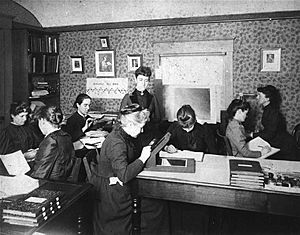Anna Winlock facts for kids
Quick facts for kids
Anna Winlock
|
|
|---|---|
| Born | September 15, 1857 |
| Died | January 4, 1904 (aged 46) |
| Nationality | United States |
| Known for | One of the first members of female computer group known as "the Harvard Computers." |
| Scientific career | |
| Fields | Astronomy |
| Institutions | Harvard College Observatory |
Anna Winlock (1857–1904) was an American astronomer. She was also a "human computer". This meant she did complex math calculations by hand. Anna was one of the first women to join a special group called "the Harvard Computers".
She created the most complete list of stars near Earth's north and south poles for her time. Anna is also known for her work on asteroids. She did important calculations for asteroids like 433 Eros and 475 Ocllo.
Contents
Early Life and Education
Anna Winlock was born on September 15, 1857. Her hometown was Cambridge, Massachusetts. Her father, Joseph Winlock, was also an astronomer. Her mother was Isabella Lane.
As a child, Anna went to the Cambridge Schools. She became very interested in both mathematics and the Greek language. When she finished school, her principal praised her Greek skills. Her father helped her develop an interest in astronomy. When she was twelve, she joined him on a trip to see a solar eclipse in Kentucky.
In June 1875, Anna's father passed away. This happened shortly after she graduated from high school. Anna soon followed in her father's footsteps. She became one of the first paid female staff members at the Harvard College Observatory.
Working at Harvard College Observatory
After her father's death, Anna needed to support her mother and four siblings. She went to the Harvard College Observatory to find a job. She was good at "reducing" observations. This meant turning many years of raw numbers into useful data. Her father had left a lot of this work unfinished.
The observatory's director said they didn't have much money to hire anyone. But Anna offered to do the calculations. She had learned about mathematical astronomy from her father. She seemed like a good fit for the observatory. Plus, they could pay her less than half the usual rate for such work. Harvard offered her twenty-five cents an hour. Anna accepted the job.
Within a year, three other women joined her at the observatory. They also worked as human computers. This group became known as the Harvard Computers. They became famous for their hard work and low pay. This set an example for other computing jobs. Anna believed it was important for women to work in astronomy. Her own success showed that women could do astronomical work just as well as men.
Major Discoveries and Contributions
Anna Winlock worked at the Harvard College Observatory for thirty years. She helped with many projects there. Her most important work was reducing and calculating meridian circle observations. This was a continuous and difficult task.
Five years before Anna started, her father had worked with other observatories. They wanted to create a huge star catalog. This project divided the sky into sections, like zones. Anna began working on the "Cambridge Zone" soon after she was hired. She worked on this project for over twenty years. Her team's work on the Cambridge Zone was a big part of the Astronomische Gesellschaft Katalog. This catalog has information on more than one hundred thousand stars. Observatories all over the world still use it today.
Besides her work on the Cambridge Zone, Anna also helped with other projects. She helped create the Observatory Annals. These were collections of tables. They showed the positions of variable stars in clusters. Her work filled 38 volumes of these important records.
Later Life and Death
Anna Winlock's death was sudden. On December 17, 1904, she visited the Harvard College Observatory for the last time. She kept working through the holiday season. The last entry in her notebook was on New Year's Day 1904. Three days later, on January 4, 1904, she died at age 47. She passed away in Boston, Massachusetts. A funeral service was held for her in Cambridge.
See also
 In Spanish: Anna Winlock para niños
In Spanish: Anna Winlock para niños


